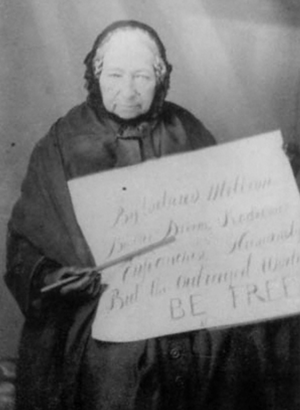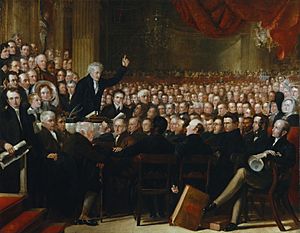Anne Knight facts for kids
Quick facts for kids
Anne Knight
|
|
|---|---|

"By tortured millions, By the divine redeemer, Enfranchise Humanity, Bid the Outraged World, BE FREE"
|
|
| Born | 2 November 1786 Chelmsford, England
|
| Died | 4 November 1862 Waldersbach, France
|
| Nationality | British |
Anne Knight (born November 2, 1786 – died November 4, 1862) was an English social reformer. She was a strong supporter of ending slavery and a key figure in starting the movement for women's rights.
In 1840, Anne Knight went to an important meeting called the World Anti-Slavery Convention. At this event, it became very clear that women needed more rights. Seven years later, in 1847, she created what many believe was the very first leaflet asking for women's suffrage. This means women should have the right to vote. In 1851, she helped create the first group in the UK focused on women's right to vote, located in Sheffield.
Anne Knight's Family
Anne Knight was born in Chelmsford, England, in 1786. Her father, William Knight (1756–1814), was a grocer in Chelmsford. Her mother was Priscilla Allen (1753–1829).
Both of Anne's parents came from Quaker families. Quakers are a religious group known for their peaceful beliefs. Many people in their families were active in movements to stop slavery and to encourage people to drink less alcohol (the temperance movement).
Early Work for Change
In 1825, Anne Knight was part of the Chelmsford Ladies' Anti-Slavery Society. She traveled around Europe with other Quakers. This trip was for sightseeing, but they also visited places where they could help good causes. Anne was very good at languages and could speak both French and German.
Anne worked closely with other important people who wanted to end slavery. These included Thomas Clarkson, Elizabeth Pease, and Joseph Sturge.

At the 1840 World Anti-Slavery Convention in London, women were not allowed to take part in the main discussions. Anne Knight was very upset by this. This event made her start campaigning for women's rights. Some women, including Anne, were shown in the painting of the convention. Other women in the painting were Elizabeth Pease, Amelia Opie, Baroness Byron, and Lucretia Mott.
In 1847, Anne Knight created what is thought to be the first leaflet ever made to support women's suffrage. This means she was asking for women to have the right to vote. She tried to convince important leaders like Henry Brougham and Richard Cobden about how important women's voting rights were. However, her efforts did not have much success at first. She also tried to work with the Chartist leaders, a group fighting for more rights for working-class men, but they were not very interested in women's voting rights.
Lucretia Mott, an American Quaker, described Anne Knight in the 1840s as "a singular looking woman – very pleasant and polite."
Moving to France
Anne Knight moved to France in 1846. She was involved in the French Revolution of 1848, which brought many changes to the country. In 1849, she attended an international peace conference in Paris.
With Jeanne Deroin, she spoke out against rules that stopped women from joining political groups. They also challenged the ban on publishing materials that supported women's rights. In 1851, Anne worked with Anne Kent to create the Sheffield Female Political Association. This was the first group in Britain to officially ask for women's suffrage, the right for women to vote.
Later Life and Legacy
Anne Knight never got married. She passed away in Waldersbach, France, on November 4, 1862. She was staying at the home of the grandson of Jean-Frédéric Oberlin, a kind person whose work she admired.
A village in Jamaica, called Knightsville, might have been named after her. It could also have been named after her younger sister, Maria, who visited the West Indies with her husband, John Candler, who also worked to end slavery.
Several places in England are named in Anne Knight's honor. Some student housing at the University of Essex is called Anne Knight House. The Colchester Quaker Housing Association opened Anne Knight House in 2005, which is a hostel for young people. There is also a historic building in Chelmsford, her birthplace, called the Anne Knight Building. It used to be a Quaker Meeting House and was later part of Anglia Ruskin University.
See also
 In Spanish: Anne Knight para niños
In Spanish: Anne Knight para niños

